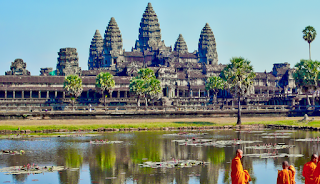Cambodia: Angkor Wat, the best preserved temple in Angkor
Angkor Wat is so emblematic of Cambodia and the greatness of the ancient Khmer Empire that the site of Angkor is often confused with this single monument, which many consider to be the eighth wonder of the world. Embark on an unforgettable journey with this excerpt from our book dedicated to the most beautiful sacred places.
Angkor ("the city"), whose construction dates back to the 9th century AD J.-C., offers the best preserved architectural testimony of what was the Khmer Empire. At its peak, it included, in addition to the current Cambodia, most of Thailand and Laos. With an estimated population of 750,000, its capital, located north of the Tonle Sap, was one of the largest cities in the medieval world.
The country had adopted the religion of India, with which it had been in contact for nearly a thousand years. The Khmer kings built magnificent Hindu temples in Angkor from 880 BC. AD Angkor Wat, built under the reign of Suryavarman II (1113-1150) and dedicated to Vishnu, is the largest and most famous of all. Its concentric square platforms, aligned on the cardinal points, draw a symbolic map of the Earth. In the center are five lotus-shaped towers, representing the five peaks of Mount Merou, the dwelling place of the gods in the Hindu cosmogony. In the inner courtyard, the walls are covered with bas-reliefs depicting episodes of Mahabharata and Ramayana, the two great epics of Hindu mythology, as well as the Khmer conquests.
Angkor Wat is surrounded by a square moat belt, symbolizing the oceans. Water is in fact everywhere in the ancient Khmer capital, covered by a network of canals and provided with two monumental reservoirs (West Baray and East Baray) that hold water inside raised dikes. These structures had a very practical and vital function: they allowed to irrigate the rice fields even during the dry season and to produce two to three harvests a year.
In 1177, the Khmer capital was occupied and ravaged by the Chams, coming from Vietnam. King Jayavarman VII took it back shortly afterwards and established Buddhism as the official religion. He built a new royal city, Angkor Thom ("the great city"), immediately north of Angkor Wat. Within the square enclosure rise many palaces and temples, including the central one of Bayon. The multiple towers of the temples are decorated with gigantic faces of Buddha and bodhisattvas, facing the four cardinal points.
Around 1430, the Khmer empire collapsed and Angkor was, for the most part, abandoned to the jungle. Only the monuments, in stone and brick, have more or less resisted the vegetation. Angkor Wat, having become a monastery ("vat"), was the best preserved. The site attracted the attention of Westerners from the 1860s, with the conquest of Cochin China by the French. An ambitious restoration program was conducted from the beginning of the 20th century. It was interrupted as of 1972, due to the civil war, then under the Khmer Rouge regime. The restoration site has resumed since the 1990s and benefits from growing tourist revenues: 500,000 people visit Angkor every year, in search of a past gone.
* Please Don't Spam Here. All the Comments are Reviewed by Admin.








